Haryana State Board HBSE 8th Class Maths Solutions Chapter 6 Square and Square Roots Ex 6.4 Textbook Exercise Questions and Answers.
Haryana Board 8th Class Maths Solutions Chapter 6 Square and Square Roots Exercise 6.4
Question 1.
Find the square root of each of the following numbers by Division method :
(i) 2304
(ii) 4489
(iii) 3481
(iv) 529
(v) 3249
(vi) 1369
(vii) 5776
(viii) 7921
(ix) 576
(x) 1024
(xi) 3136
(xii) 900
Solution:
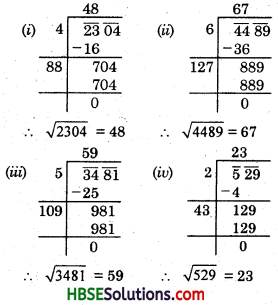
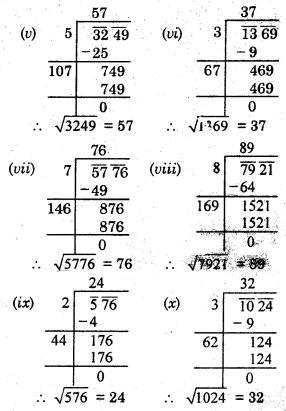
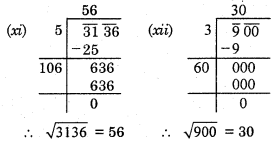
![]()
Question 2.
Find the number of digits in the square root of each of the following numbers (without any calculation).
(i) 64
(ii) 144
(iii) 4489
(iv) 27225
(v) 390625.
Solution:
(i) 64, Here n = 2 (even)
Number of digits in the square root of 64
= \(\frac{n}{2}\) = \(\frac{2}{2}\) = 1
(ii) Here, n = 3 (odd)
No. of digits in the square root of 144
= \(\frac{n+1}{2}\) = \(\frac{3+1}{2}\) = 2
(iii) 4489, Here n = 4 (even)
∴ No. of digits in the square root of 4489
= \(\frac{n}{2}\) = \(\frac{4}{2}\) = 2
(iv) 27225, Here n = 5 (odd)
No. of digits in the square root of 27225 = n+1 5+1
= \(\frac{n+1}{2}\) = \(\frac{5+1}{2}\) = 3
(v) 390625, Here n = 6 (even)
∴ The number of digits in the square root of
390625 = \(\frac{n}{2}\) = \(\frac{6}{2}\) = 3
Question 3.
Find the square root of the following decimal numbers :
(i) 2.56
(ii) 7.29
(iii) 51.84
(iv) 42.25
(v) 31.36
Solution:


![]()
Question 4.
Find the least number which must be subtracted from each of the following numbers so as to get a perfect square. Also find the square root of the perfect square so obtained.
(i) 402
(ii) 1989
(iii) 3250
(iv) 825
(v) 4000.
Solution:
(i) 
We get remainder 2. It shows that 202 is less than 402 by 2.
Thus, the number to be subtracted so as to make it a perfect a square is 2.
∴ Required perfect square
= 402 – 2 = 400
and \(\sqrt {400}\) = 20
(ii) 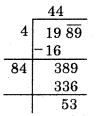
We get remainder 53. It shows that 442 is less than 1989 by 53.
Thus, the number to be subtracted so as to make it a perfect square is 3.
∴ Required perfect square
= 1989 – 53 = 1936
and \(\sqrt {1936}\) = 44.
(iii) We get the remainder 1.
It shows that 572 is less than 3250 by 1.
Thus, the number to be subtracted so as to make 3250 a perfect square is 1.

∴ Required number
= 3250 – 1 = 3249
and \(\sqrt {3249}\) = 57
(iv) We get the remainder 41.
It shows that 282 is less than 825 by 41.
Thus, the smallest number that should be subtracted to make it a perfect square is 41.

∴ Required number = 825 – 41 = 784
and \(\sqrt {784}\) = 28
(v) Since remainder 31.
∴ The smallest number that should be subtracted to make it a perfect square is 31.

and Required number
= 4000 – 31
= 3969
and \(\sqrt {3669}\) = 63.
![]()
Question 5.
Find the least number which must be added to each of the following numbers so as to get a perfect square. Also find the square root of the perfect square so obtained.
(i) 525
(ii) 1750
(iii) 252
(iv) 1825
(v) 6412.
Solution:
(i) Since remainderis 41.
∴ 222 < 525

Next perfect square number is 232 = 529
Hence, the number to be added is
232 – 525 = 529 – 525 = 4
∴ The required no. = 525 + 4 = 529
and \(\sqrt {529}\) = 23
(ii) It is clear by long division method of \(\sqrt {1750}\) that remainder is 69.

It shows that 412 < 1750
Next perfect square is 422
= 1764
Hence, the number to be added is 422 – 1750
= 1764 – 1750 = 14.
∴ Required number
= 1750 + 14 = 1764
and \(\sqrt {1764}\) = 42
(iii) ∵ Remainder = 27
∴ 152 < 252 < 162.
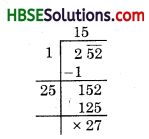
Hence, the required number to be added to make it a perfect square
= 162 – 252
= 256 – 252 = 4
and \(\sqrt {256}\) = 16.
(iv) ∵ Remainder = 61

∴ 422 < 1825 < 432
432 = 1849
Hence, the required number to be added to make it a perfect square
= 432 – 1825
= 1849 – 1825 = 24
∴ \(\sqrt {1849}\) = 43.
(v) Since remainder = 12.

∴ 802 < 6412 < 812
∴ Required no. to be added to make it a perfect square is
812 – 6412 = 6561 – 6412
= 149
∴ \(\sqrt {6561}\) = 81.
Question 6.
Find the length of the side of a square whose area is 441 m2.
Solution:
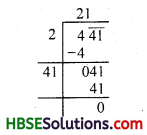
Let the side of square be x.
then, area of a square = x2
∴ x2 = 441
⇒ x = \(\sqrt {441}\)
= 21 m.
![]()
Question 7.
In a right triangle ABC, ∠B = 90°.
(а) If AB = 6cm, BC = 8cm, findAC.
(б) If AC = 13 cm, BC = 5 cm, find AB.
Solution:
(i) Using Pythagoras theorem
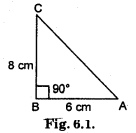
AC2 = AB2 + BC2
= 62 + 82
= 36 + 64
= 100
⇒ AC = \(\sqrt {100}\)
= 10 cm
(ii) AC = 13 cm
BC = 5 cm
AC2 = AB2 + BC2
(Using Pythagoras theorem)
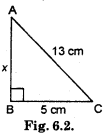
(13)2 = x2 + (5)2
⇒ 169 = x2 + 25
⇒ 169 – 25 = x2
⇒ 144 = x2
⇒ x = \(\sqrt {144}\) = 12 cm
Question 8.
A gardener has 1000 plants. He wants to plant these in such a way that the number of rows and the number of columns remain same. Find the minimum number of plants he needs more for this.
Solution:
By prime factorisation, we get
1000 = 2 × \(\underline{2 \times 2}\) × 5 × \(\underline{5 \times 5}\)
We see that 2 and 5 are still unpaired.

∴ We have to multiply 1000 by 2 × 5 i.e., 10 to make it a perfect square.
Required number of plants
∴ 1000 × 10 = 10000
Thus, he needed 10 more plants.
![]()
Question 9.
There are 500 children in a school. For a P.T. drill they have to stand in such a manner that the number of rows is equal to number of columns. How many children would be left out in this arrangement ?
Solution:
By prime factorisation, we get

500 = \(\underline{2 \times 2}\) × \(\underline{5 \times 5}\) × 5
Since 5 is not in pair.
∴ 5 children would be left out in this arrangement.